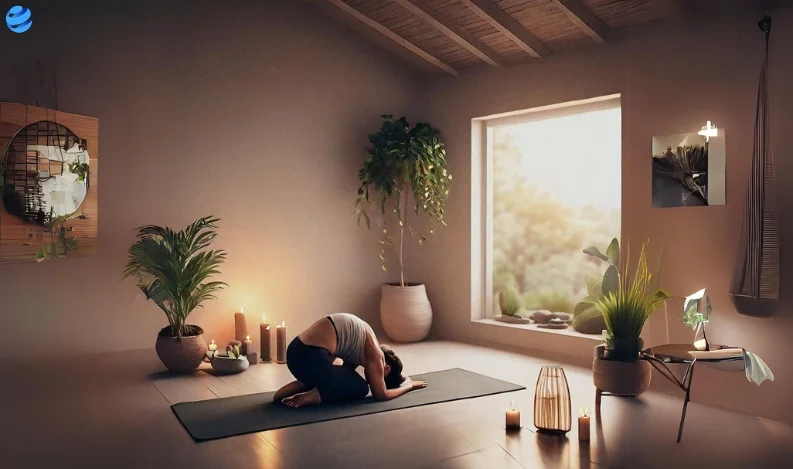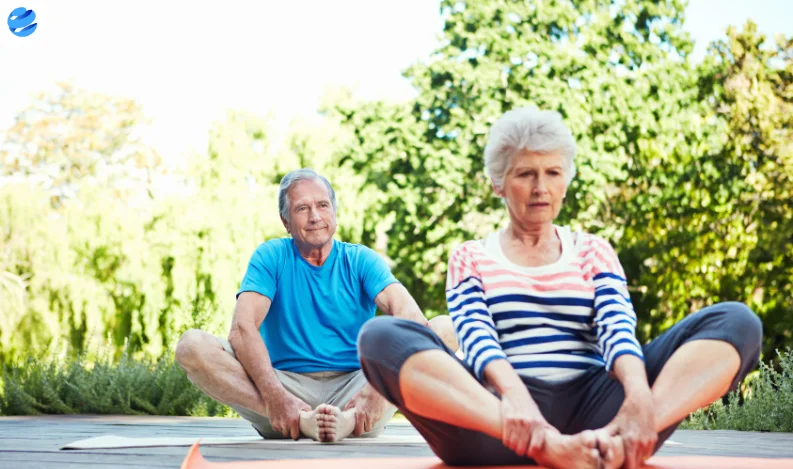In today’s busy world, stress is a common feeling. Many people find it hard to relax and feel calm. Yoga is a great way to help with this. It is a practice that can make you feel more peaceful and less stressed. This blog will teach you about yoga and how it can help you feel calm. We will explore various yoga poses that are easy to do and very helpful. By learning these poses, you can take care of both your body and mind.
What is Yoga?
Yoga is an ancient practice that started in India. It combines physical exercises, breathing techniques, and meditation. The goal of yoga is to create balance in the body and mind. It helps you to be aware of your body and thoughts.
The Basics of Yoga
Yoga involves different movements called poses. These poses help stretch and strengthen your body. You also focus on your breathing, which helps you relax. Yoga is not just about physical exercise. It also involves calming the mind and improving mental focus.
How Yoga Helps with Stress
When you are stressed, your body reacts in different ways. Your muscles may become tight, and your mind may feel overwhelmed. Yoga helps by relaxing your muscles and calming your mind. It teaches you how to control your breathing and focus your thoughts. By practising yoga, you can reduce stress and feel more at ease.
Benefits of Yoga for Stress Relief
Yoga offers many benefits that help with stress relief. Here are some of the main advantages:
Reduces Muscle Tension
When you are stressed, your muscles can become tight and tense. Yoga helps to release this tension. By stretching and relaxing your muscles, you can feel more comfortable and relaxed.
Calms the Mind
Yoga includes breathing exercises and meditation. These practices help to calm your mind and reduce anxiety. By focusing on your breath, you can let go of stressful thoughts and feelings.
Improves Sleep
Stress can make it hard to sleep. Yoga helps to improve your sleep by relaxing your body and mind. By practising yoga regularly, you can fall asleep more easily and have better quality sleep.
Enhances Mood
Yoga can help improve your mood. It releases chemicals in the brain called endorphins that make you feel happy. By doing yoga, you can boost your mood and feel more positive.
Increases Self-Awareness
Yoga helps you become more aware of your body and mind. This self-awareness can help you understand your stress triggers and find ways to manage them better.
Easy Yoga Poses for Stress Relief
In this section, we will explore some easy yoga poses that can help you feel more relaxed. Each pose has its own benefits and can be done at home or in a yoga class.
1. Child’s Pose
Description:
Child’s Pose is a simple and calming pose. It helps to stretch your back and relax your mind.
How to Do It:
-
Kneel on the floor with your toes touching and knees apart.
-
Sit back on your heels and stretch your arms forward.
-
Rest your forehead on the ground and breathe deeply.
Benefits:
-
Stretches the back and hips.
-
Calms the mind and reduces stress.
-
Helps to relieve tension in the body.
Tips:
-
Keep your arms extended to feel a deeper stretch.
-
If you feel discomfort, place a pillow under your forehead.
2. Cat-Cow Pose
Description:
Cat-Cow Pose is a gentle movement that helps to release tension in your back and neck.
How to Do It:
-
Start on your hands and knees.
-
Arch your back up like a cat and tuck your chin to your chest.
-
Then, lower your belly and lift your head and tailbone up like a cow.
-
Move between these two positions slowly.
Benefits:
-
Stretches and strengthens the spine.
-
Relieves back tension and improves flexibility.
-
Helps to calm the mind.
Tips:
-
Move slowly and breathe deeply.
-
Ensure your movements are smooth and controlled.
3. Forward Bend
Description:
Forward Bend is a simple pose that stretches your hamstrings and lower back. It helps to calm your mind and reduce anxiety.
How to Do It:
-
Stand with your feet together.
-
Slowly bend forward from your hips, letting your arms hang down.
-
Try to touch your toes, or just let your hands hang down.
Benefits:
-
Stretches the hamstrings and lower back.
-
Helps to calm the nervous system.
-
Reduces anxiety and stress.
Tips:
-
Bend your knees slightly if you feel tightness in your hamstrings.
-
Relax your neck and shoulders while bending forward.
4. Legs-Up-The-Wall Pose
Description:
Legs-Up-The-Wall Pose is a restorative pose that helps to calm the nervous system and improve circulation.
How to Do It:
-
Sit next to a wall and lie down on your back.
-
Lift your legs up and rest them against the wall.
-
Keep your arms by your sides and relax.
Benefits:
-
Calms the nervous system.
-
Improves circulation and reduces fatigue.
-
Helps to relax and restore energy.
Tips:
-
Use a folded blanket or cushion under your hips for added comfort.
-
Stay in the pose for 5-10 minutes for maximum relaxation.
5. Bridge Pose
Description:
Bridge Pose strengthens the back and legs while also helping to reduce stress and improve mood.
How to Do It:
-
Lie on your back with your knees bent and feet flat on the floor.
-
Lift your hips up towards the ceiling.
-
Keep your shoulders and feet on the ground and hold the pose for a few breaths.
Benefits:
-
Strengthens the back, glutes, and legs.
-
Helps to reduce stress and anxiety.
-
Improves mood and energy levels.
Tips:
-
Use your hands to support your lower back if needed.
-
Keep your chin slightly tucked to avoid straining your neck.
Tips for Practising Yoga
To get the most out of your yoga practice, follow these tips:
Find a Quiet Space
Choose a calm and quiet place to do your yoga. This helps you focus and relax better. Avoid areas with loud noises or distractions.
Use a Mat
A yoga mat provides a comfortable surface for you to do your poses. It also helps to prevent slipping and provides cushioning for your joints.
Breathe Deeply
Focus on your breathing while doing yoga. Deep breaths help you feel more relaxed and centred. Inhale through your nose and exhale through your mouth.
Listen to Your Body
Move slowly and gently. If a pose feels uncomfortable, stop and try a different one. It’s important to listen to your body and not push yourself too hard.
Stay Consistent
Practise yoga regularly to see the best results. Even a few minutes each day can help you feel more relaxed and reduce stress. Find a time that works for you and make it a part of your routine.
How Often Should You Do Yoga?
You don’t need to do yoga every day to feel its benefits. Practising a few times a week can be enough. Choose a schedule that fits your lifestyle and stick to it. You can also try different types of yoga to find what works best for you.
Combining Yoga with Other Relaxation Techniques
Yoga is just one way to reduce stress. You can combine it with other relaxation techniques for even more benefits.
Meditation
Meditation helps to calm the mind and improve focus. Try meditating for a few minutes before or after your yoga practice. It can help you feel more centred and peaceful.
Deep Breathing Exercises
Deep breathing exercises help to reduce stress and anxiety. Practise deep breathing along with your yoga poses to enhance relaxation.
Mindfulness
Mindfulness involves paying attention to the present moment. It can help you manage stress and improve your overall well-being. Incorporate mindfulness into your yoga practice by focusing on your breath and movements.
Common Mistakes to Avoid
While practising yoga, avoid these common mistakes:
Overstretching
Don’t push yourself too hard in a pose. Overstretching can cause injury. Move gently and only stretch as far as comfortable.
Holding Your Breath
Remember to breathe deeply while doing yoga. Holding your breath can increase tension and stress. Focus on your breath throughout your practice.
Skipping Warm-Up and Cool-Down
Always warm up before starting your yoga practice and cool down afterwards. This helps to prevent injury and improves flexibility. Include gentle stretches and breathing exercises in your warm-up and cool-down routine.
Yoga for All Ages
Yoga is suitable for people of all ages. Whether you are a child, adult, or senior, yoga can benefit you. It helps to improve flexibility, strength, and balance. Yoga also promotes relaxation and well-being for everyone.
Yoga for Children
Children can benefit from yoga too. It helps them to develop strength, balance, and coordination. Yoga can also help children manage stress and improve their focus.
Yoga for Seniors
Yoga is gentle and can be adapted for seniors. It helps to improve mobility, balance, and flexibility. Seniors can also benefit from the relaxation and stress-relief aspects of yoga.
Conclusion
Yoga is a wonderful practice for reducing stress and finding peace. By doing simple poses like Child’s Pose and Forward Bend, you can help your body and mind feel more relaxed. Remember to practise regularly, listen to your body, and focus on your breathing. With these easy yoga poses, you can enjoy a calmer, more peaceful life. Yoga is a great way to take care of yourself and improve your well-being. Give it a try and see how it can help you feel better.
You may also like:-
Harness the power of yoga to manage stress with gentle poses that promote relaxation, peace, and mental clarity.













